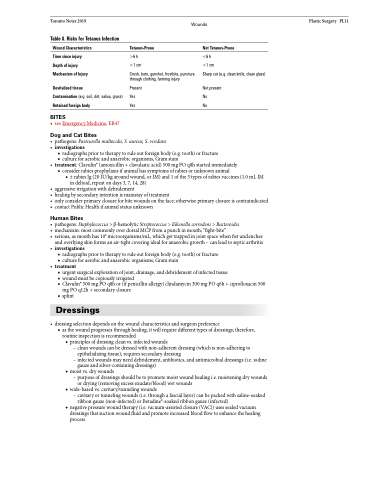Page 1133 - TNFlipTest
P. 1133
Toronto Notes 2019
Wounds
Plastic Surgery PL11
Table 8. Risks for Tetanus Infection
Wound Characteristics
Time since injury Depth of injury Mechanism of Injury
Devitalized tissue
Contamination (e.g. soil, dirt, saliva, grass) Retained foreign body
BITES
• seeEmergencyMedicine,ER47
Dog and Cat Bites
Tetanus-Prone
>6 h >1 cm
Crush, burn, gunshot, frostbite, puncture through clothing, farming injury
Present Yes Yes
Not Tetanus-Prone
<6 h
<1 cm
Sharp cut (e.g. clean knife, clean glass)
Not present No
No
• pathogens:Pasteurellamultocida,S.aureus,S.viridans • investigations
■ radiographs prior to therapy to rule out foreign body (e.g. tooth) or fracture
■ culture for aerobic and anaerobic organisms, Gram stain
• treatment:Clavulin®(amoxicillin+clavulanicacid)500mgPOq8hstartedimmediately
■ consider rabies prophylaxis if animal has symptoms of rabies or unknown animal
◆ ± rabies Ig (20 IU/kg around wound, or IM) and 1 of the 3 types of rabies vaccines (1.0 mL IM
in deltoid, repeat on days 3, 7, 14, 28)
• aggressiveirrigationwithdebridement
• healingbysecondaryintentionismainstayoftreatment
• onlyconsiderprimaryclosureforbitewoundsontheface;otherwiseprimaryclosureiscontraindicated • contactPublicHealthifanimalstatusunknown
Human Bites
• pathogens:Staphylococcus>β-hemolyticStreptococcus>Eikenellacorrodens>Bacteroides
• mechanism:mostcommonlyoverdorsalMCPfromapunchinmouth;“fight-bite”
• serious, as mouth has 109 microorganisms/mL, which get trapped in joint space when fist unclenches
and overlying skin forms an air-tight covering ideal for anaerobic growth – can lead to septic arthritis • investigations
■ radiographs prior to therapy to rule out foreign body (e.g. tooth) or fracture
■ culture for aerobic and anaerobic organisms, Gram stain • treatment
■ urgent surgical exploration of joint, drainage, and debridement of infected tissue
■ wound must be copiously irrigated
■ Clavulin® 500 mg PO q8h or (if penicillin allergy) clindamycin 300 mg PO q6h + ciprofloxacin 500
mg PO q12h + secondary closure ■ splint
Dressings
• dressingselectiondependsonthewoundcharacteristicsandsurgeonpreference
■ as the wound progresses through healing, it will require different types of dressings; therefore,
routine inspection is recommended
◆ principles of dressing clean vs. infected wounds
– clean wounds can be dressed with non-adherent dressing (which is non-adhering to epithelializing tissue); requires secondary dressing
– infected wounds may need debridement, antibiotics, and antimicrobial dressings (i.e. iodine gauze and silver-containing dressings)
◆ moist vs. dry wounds
– purpose of dressings should be to promote moist wound healing i.e. moistening dry wounds
or drying (removing excess exudate/blood) wet wounds
◆ wide-based vs. cavitary/tunneling wounds
– cavitary or tunneling wounds (i.e. through a fascial layer) can be packed with saline-soaked ribbon gauze (non-infected) or Betadine®-soaked ribbon gauze (infected)
◆ negative pressure wound therapy (i.e. vacuum-assisted closure (VAC)) uses sealed vacuum dressings that suction wound fluid and promote increased blood flow to enhance the healing process


